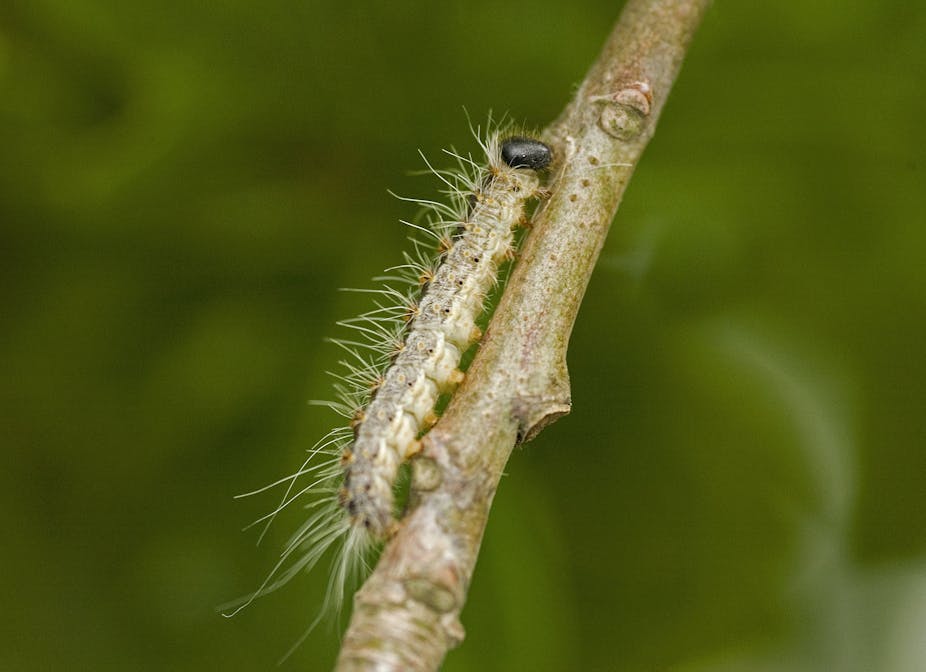As thousands of people have descended on the Chelsea Flower Show this week, one exhibit has startled visitors by contrasting its beautiful sunken garden with a sinister avenue of dead trees.
Designed by Jo Thompson for the Food Environment Research Agency (Fera), the Stop The Spread garden opposes lush and lifeless elements to highlight the threat posed by invasive species to our native plant and animal life - and suggests measures the public can take to help.

Invasive species are animals and plants not native to an area that once introduced can spread and cause damage to the environment, the economy or human well-being. According to the Centre for Agricultural Bioscience International (CABI), they are estimated to cost the UK more than £1.7 billion a year.
While there are several thousand non-native species present in Britain, only a small number are considered invasive and need to be actively managed.
One of these is the oak processionary moth, whose larvae (caterpillars) can strip oak trees bare of leaves. In a scene that blends Gardeners’ Question Time with Apocalypse Now, pesticide-armed helicopters will this month spray Berkshire woodlands to try and halt the caterpillars’ advance. Pitting helicopters against moths might seem extreme, but by putting effort into managing them now it’s hoped we can avoid the impacts seen on the continent, which include severe damage to oaks and rashes and respiratory disorders in humans from the caterpillars’ irritant hairs.

Preventing potentially harmful species from reaching our shores is generally the most cost-effective and environmentally friendly solution. But as this isn’t always possible - potential invaders have been known to hitch a lift as stowaways in a wide range of products from food stuffs to Christmas decorations, or, in the case of the oak processionary moth, on imported trees - taking a tougher line to control or even eradicate them may be necessary.
Mechanical, chemical and biological tools
Different ways to repel the invaders have been tried, with varying degrees of success. Traditional means include physical removal, for example pulling up the invasive plant Himalayan balsam, known among conservationists as “balsam-bashing”. Machines can help too, to trap or mow or gather - using diggers to drag up invasive aquatic plants such as floating pennywort from ponds and rivers, for example, and chemicals such as pesticides or herbicides are widely used.

Classical biological methods replace the absence of natural predators many invaders enjoy by recruiting the enemies they would have faced in their natural habitat.
This is not a new idea - indeed, the New World is full of introduced species. Some of these have been a help but others, like the cane toad in Australia, have gone on to be more harmful than the species they were introduced to manage.
For the first time in Europe, a tiny psyllid insect from Japan was introduced to Britain in 2010 to help control Japanese knotweed. The psyllid will not eradicate the weed, but hopefully will suppress its growth to provide long term control.
Technological advances are helping scientists develop new, more effective treatments to control invasive species while minimising the environmental impact of the methods used against them.
The invasive species can even be turned against itself, using subtle chemical cues such as pheromones, or in the case of the afore-mentioned cane toad, its own toxins, to lure individuals into traps.
Another example is [genetic biocontrol](http://link.springer.com/article/10.1007%2Fs10530-013-0475-2](http://link.springer.com/article/10.1007%2Fs10530-013-0475-2), used to eradicate invasive fish. By introducing reproductive individuals with particular genetic make-up, the population sex ratio can be gradually shifted towards male, until the point at which the fish are unable to sustain a reproducing population.
Diseases provide another option. In Australia, myxomatosis and haemorrhagic disease have been released to control invasive rabbits, leading to significant reductions in populations. The ever-breeding rabbit may be starting to recover, however, which means that new techniques will be needed.
Living with the new neighbours
While many invasive species will require on-going management, there are examples of successful eradications. The coypu, a large rodent from South America, was originally brought to Britain for fur farming but subsequently escaped. Having reached a population peak of 200,000, problems caused by grazing and burrowing meant that the coypus’ days were numbered; after substantial effort they were successfully eradicated during the 1980s.

In Britain, there are ongoing attempts to eradicate other invasive species including the Asian longhorn beetle and ruddy duck. Efforts to tackle species like the American mink and grey squirrel aim instead to ensure pest-free areas where vulnerable native species like water voles and red squirrels can recover, even if the invasive aggressors cannot be eradicated completely.
The last few individuals are often the most difficult to remove. Here again, the invaders themselves can be recruited to help. To aid removal of feral goats from Santiago Island in the Galapagos, so called “Judas animals” fitted with transmitter collars were released to lead hunters to remaining animals, while sterile females were used to draw out males.
Future developments will lead to more inventive ways of managing problem species. But in an increasingly globalised and well-connected world, until we are able to prevent new introductions from reaching our shores in the first place, the rapid targeting of recent arrivals like the oak processionary moth - even by airborne assault if need be - are exactly the steps that need to be taken.

